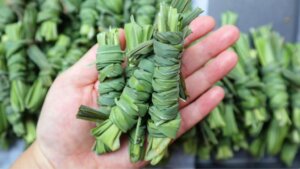Storing and Wrapping Lemongrass Leaves: Tips for Freshness

Why Proper Storage Matters
Lemongrass, like many herbs, begins to lose its flavor and nutritional benefits as soon as it’s harvested. Proper storage not only helps maintain its delightful aroma and taste but also ensures you can enjoy its health benefits whenever you need it.
Preparing Lemongrass for Storage
Step 1: Cleaning
- Start by gently rinsing the lemongrass stalks under cold water to remove any dirt or debris.
- Pat them dry with a clean towel to remove excess moisture, which can lead to mold or spoilage.
Step 2: Trimming
- Trim the root end just a bit to freshen up the base, which can help in absorbing moisture if you choose to store them in water.
- Remove any outer layers that seem too tough or dried out.
Storing Lemongrass
Option 1: In the Refrigerator
- Wrapping in Paper: Wrap the lemongrass loosely in a damp paper towel. This provides the right amount of moisture without soaking the herb.
- Placing in a Plastic Bag: After wrapping, place the lemongrass in a plastic bag. Do not seal the bag completely; allowing a bit of air circulation will prevent too much moisture from accumulating, which could cause decay.
Option 2: In Water
- Using a Jar or Vase: Trim the ends of the lemongrass and place the stalks in a jar or vase filled with a small amount of water. Only the root ends should be submerged.
- Changing Water Regularly: Change the water every few days to keep it fresh and clear of bacteria.
Option 3: Freezing
- Prepping for Freezer: If you don’t plan to use the lemongrass soon, you can chop it into pieces and freeze it.
- Storage Method: Place the chopped lemongrass in an airtight container or a sealable freezer bag. Frozen lemongrass can last for several months and can be used directly in cooking without thawing.
Tips for Longevity
- Check the lemongrass regularly, especially if stored in the refrigerator, for any signs of spoilage or mold.
-
Always keep the lemongrass dry and clean before storage to extend its life.
- Back Home
